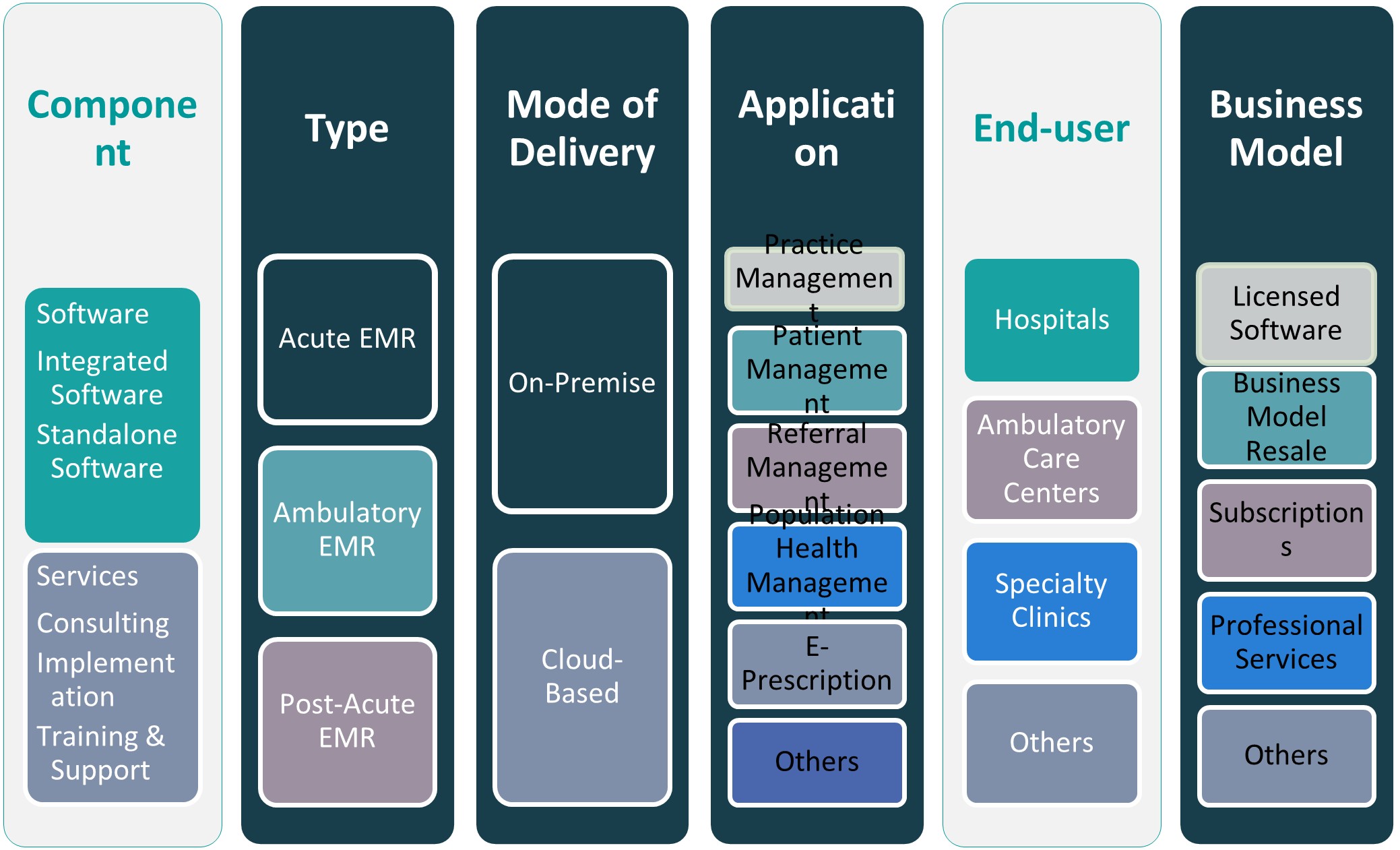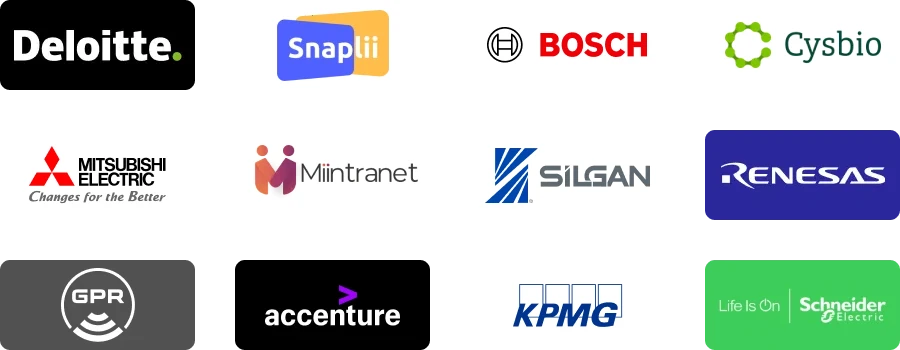CHAPTER NO. 1 : INTRODUCTION 19
1.1. Report Description 19
Purpose of the Report 19
USP & Key Offerings 19
1.2. Key Benefits for Stakeholders 19
1.3. Target Audience 20
1.4. Report Scope 20
CHAPTER NO. 2 : EXECUTIVE SUMMARY 21
2.1. UK Electronic Medical Record Market Snapshot 21
2.2. UK Electronic Medical Record Market, 2018 – 2032 (USD Million) 23
CHAPTER NO. 3 : UK ELECTRONIC MEDICAL RECORD MARKET – INDUSTRY ANALYSIS 24
3.1. Introduction 24
3.2. Market Drivers 25
3.2.1. Increased Demand for Digitization of Healthcare Data 25
3.2.2. Growing Adoption of Cloud-Based EMR Solutions 26
3.3. Market Restraints 27
3.3.1. High Initial Costs and Maintenance Expenses 27
3.4. Market Opportunities 28
3.4.1. Market Opportunity Analysis 28
3.5. Porter’s Five Forces Analysis 29
CHAPTER NO. 4 : ANALYSIS COMPETITIVE LANDSCAPE 30
4.1. Company Market Share Analysis – 2024 30
4.1.1. UK Electronic Medical Record Market: Company Market Share, by Revenue, 2024 30
4.1.2. UK Electronic Medical Record Market: Top 6 Company Market Share, by Revenue, 2024 31
4.1.3. UK Electronic Medical Record Market: Top 3 Company Market Share, by Revenue, 2024 32
4.2. UK Electronic Medical Record Market Company Revenue Market Share, 2024 33
4.3. Company Assessment Metrics, 2024 34
4.3.1. Stars 34
4.3.2. Emerging Leaders 34
4.3.3. Pervasive Players 34
4.3.4. Participants 34
4.4. Start-ups /SMEs Assessment Metrics, 2024 34
4.4.1. Progressive Companies 34
4.4.2. Responsive Companies 34
4.4.3. Dynamic Companies 34
4.4.4. Starting Blocks 34
4.5. Strategic Developments 35
4.5.1. Acquisitions & Mergers 35
New Product Launch 35
UK Expansion 35
4.6. Key Players Product Matrix 36
CHAPTER NO. 5 : PESTEL & ADJACENT MARKET ANALYSIS 37
5.1. PESTEL 37
5.1.1. Political Factors 37
5.1.2. Economic Factors 37
5.1.3. Social Factors 37
5.1.4. Technological Factors 37
5.1.5. Environmental Factors 37
5.1.6. Legal Factors 37
5.2. Adjacent Market Analysis 37
CHAPTER NO. 6 : UK ELECTRONIC MEDICAL RECORD MARKET – BY COMPONENT SEGMENT ANALYSIS 38
6.1. UK Electronic Medical Record Market Overview, by Component Segment 38
6.1.1. UK Electronic Medical Record Market Revenue Share, By Component, 2024 & 2032 39
6.1.2. UK Electronic Medical Record Market Attractiveness Analysis, By Component 40
6.1.3. Incremental Revenue Growth Opportunity, by Component, 2025 – 2032 41
6.1.4. UK Electronic Medical Record Market Revenue, By Component, 2018, 2023, 2027 & 2032 42
6.2. Software 43
6.2.1. Integrated Software 44
6.2.2. Standalone Software 45
6.3. Services 46
6.3.1. Consulting 47
6.3.2. Implementation 48
6.3.3. Training & Support 49
CHAPTER NO. 7 : UK ELECTRONIC MEDICAL RECORD MARKET – BY TYPE SEGMENT ANALYSIS 50
7.1. UK Electronic Medical Record Market Overview, by Type Segment 50
7.1.1. UK Electronic Medical Record Market Revenue Share, By Product Type, 2024 & 2032 51
7.1.2. UK Electronic Medical Record Market Attractiveness Analysis, By Type 52
7.1.3. Incremental Revenue Growth Opportunity, by Type, 2025 – 2032 53
7.1.4. UK Electronic Medical Record Market Revenue, By Type, 2018, 2023, 2027 & 2032 54
7.2. Acute EMR 55
7.3. Ambulatory EMR 56
7.4. Post-Acute EMR 57
CHAPTER NO. 8 : UK ELECTRONIC MEDICAL RECORD MARKET – BY MODE OF DELIVERY SEGMENT ANALYSIS 58
8.1. UK Electronic Medical Record Market Overview, by Mode of Delivery Segment 58
8.1.1. UK Electronic Medical Record Market Revenue Share, By Mode of Delivery, 2024 & 2032 59
8.1.2. UK Electronic Medical Record Market Attractiveness Analysis, By Mode of Delivery 60
8.1.3. Incremental Revenue Growth Opportunity, by Mode of Delivery, 2025 – 2032 61
8.1.4. UK Electronic Medical Record Market Revenue, By Mode of Delivery, 2018, 2023, 2027 & 2032 62
8.2. On-Premise 63
8.3. Cloud-Based 64
CHAPTER NO. 9 : UK ELECTRONIC MEDICAL RECORD MARKET – BY APPLICATION SEGMENT ANALYSIS 65
9.1. UK Electronic Medical Record Market Overview, by Application Segment 65
9.1.1. UK Electronic Medical Record Market Revenue Share, By Application, 2024 & 2032 66
9.1.2. UK Electronic Medical Record Market Attractiveness Analysis, By Application 67
9.1.3. Incremental Revenue Growth Opportunity, by Application, 2025 – 2032 68
9.1.4. UK Electronic Medical Record Market Revenue, By Application, 2018, 2023, 2027 & 2032 69
9.2. Practice Management 70
9.3. Patient Management 71
9.4. Referral Management 72
9.5. Population Health Management 73
9.6. E-Prescription 74
9.7. Others 75
CHAPTER NO. 10 : UK ELECTRONIC MEDICAL RECORD MARKET – BY BUSINESS MODEL SEGMENT ANALYSIS 76
10.1. UK Electronic Medical Record Market Overview, by Business Model Segment 76
10.1.1. UK Electronic Medical Record Market Revenue Share, By Business Model, 2024 & 2032 77
10.1.2. UK Electronic Medical Record Market Attractiveness Analysis, By Business Model 78
10.1.3. Incremental Revenue Growth Opportunity, by Business Model, 2025 – 2032 79
10.1.4. UK Electronic Medical Record Market Revenue, By Business Model, 2018, 2023, 2027 & 2032 80
10.2. Licensed Software 81
10.3. Business Model Resale 82
10.4. Subscriptions 83
10.5. Professional Services 84
10.6. Others 85
CHAPTER NO. 11 : UK ELECTRONIC MEDICAL RECORD MARKET – BY END USER SEGMENT ANALYSIS 86
11.1. UK Electronic Medical Record Market Overview, by End User Segment 86
11.1.1. UK Electronic Medical Record Market Revenue Share, By End User, 2024 & 2032 87
11.1.2. UK Electronic Medical Record Market Attractiveness Analysis, By End User 88
11.1.3. Incremental Revenue Growth Opportunity, by End User, 2025 – 2032 89
11.1.4. UK Electronic Medical Record Market Revenue, By End User, 2018, 2023, 2027 & 2032 90
11.2. Hospitals 91
11.3. Ambulatory Care Centers 92
11.4. Specialty Clinics 93
11.5. Others 94
CHAPTER NO. 12 : UK MEDICAL RECORD MARKET –ANALYSIS 95
12.1. Component 95
12.1.1. UK Medical Record Market Revenue, By Component, 2018 – 2023 (USD Million) 95
12.1.2. UK Medical Record Market Revenue, By Component, 2024 – 2032 (USD Million) 95
12.2. Type 96
12.2.1. UK Medical Record Market Revenue, By Type, 2018 – 2023 (USD Million) 96
12.2.2. UK Medical Record Market Revenue, By Type, 2024 – 2032 (USD Million) 96
12.3. Mode of Delivery 97
12.3.1. UK Medical Record Market Revenue, By Mode of Delivery, 2018 – 2023 (USD Million) 97
12.3.2. UK Medical Record Market Revenue, By Mode of Delivery, 2024 – 2032 (USD Million) 97
12.4. Application 98
12.4.1. UK Medical Record Market Revenue, By Application, 2018 – 2023 (USD Million) 98
12.4.2. UK Medical Record Market Revenue, By Application, 2024 – 2032 (USD Million) 98
12.5. End-user 99
12.5.1. UK Medical Record Market Revenue, By End-user, 2018 – 2023 (USD Million) 99
12.5.2. UK Medical Record Market Revenue, By End-user, 2024 – 2032 (USD Million) 99
12.6. Business Model 100
12.6.1. UK Medical Record Market Revenue, By Business Model, 2018 – 2023 (USD Million) 100
12.6.2. UK Medical Record Market Revenue, By Business Model, 2024 – 2032 (USD Million) 100
CHAPTER NO. 13 : COMPANY PROFILES 101
13.1. Epic Systems Corp 101
13.1.1. Company Overview 101
13.1.2. Product Portfolio 101
13.1.3. Swot Analysis 101
13.1.4. Business Strategy 102
13.1.5. Financial Overview 102
13.2. Cerner Corporation 103
13.3. InPS 103
13.4. System C & Graphnet Health 103
13.5. TPP 103
13.6. Company 6 103
13.7. Company 7 103
13.8. Company 8 103
13.9. Company 9 103
13.10. Company 10 103
List of Figures
FIG NO. 1. UK Electronic Medical Record Market Revenue, 2018 – 2032 (USD Million) 23
FIG NO. 2. Porter’s Five Forces Analysis for UK Electronic Medical Record Market 29
FIG NO. 3. Company Share Analysis, 2024 30
FIG NO. 4. Company Share Analysis, 2024 31
FIG NO. 5. Company Share Analysis, 2024 32
FIG NO. 6. UK Electronic Medical Record Market – Company Revenue Market Share, 2024 33
FIG NO. 7. UK Electronic Medical Record Market Revenue Share, By Component, 2024 & 2032 39
FIG NO. 8. Market Attractiveness Analysis, By Component 40
FIG NO. 9. Incremental Revenue Growth Opportunity by Component, 2025 – 2032 41
FIG NO. 10. UK Electronic Medical Record Market Revenue, By Component, 2018, 2023, 2027 & 2032 42
FIG NO. 11. UK Electronic Medical Record Market for Software, Revenue (USD Million) 2018 – 2032 43
FIG NO. 12. UK Electronic Medical Record Market for Integrated Software, Revenue (USD Million) 2018 – 2032 44
FIG NO. 13. UK Electronic Medical Record Market for Standalone Software, Revenue (USD Million) 2018 – 2032 45
FIG NO. 14. UK Electronic Medical Record Market for EMR Services, Revenue (USD Million) 2018 – 2032 46
FIG NO. 15. UK Electronic Medical Record Market for Consulting, Revenue (USD Million) 2018 – 2032 47
FIG NO. 16. UK Electronic Medical Record Market for Implementation, Revenue (USD Million) 2018 – 2032 48
FIG NO. 17. UK Electronic Medical Record Market for Training & Support, Revenue (USD Million) 2018 – 2032 49
FIG NO. 18. UK Electronic Medical Record Market Revenue Share, By Product Type, 2024 & 2032 51
FIG NO. 19. Market Attractiveness Analysis, By Type 52
FIG NO. 20. Incremental Revenue Growth Opportunity by Type, 2025 – 2032 53
FIG NO. 21. UK Electronic Medical Record Market Revenue, By Type, 2018, 2023, 2027 & 2032 54
FIG NO. 22. UK Electronic Medical Record Market for Acute EMR, Revenue (USD Million) 2018 – 2032 55
FIG NO. 23. UK Electronic Medical Record Market for Ambulatory EMR, Revenue (USD Million) 2018 – 2032 56
FIG NO. 24. UK Electronic Medical Record Market for Post-Acute EMR, Revenue (USD Million) 2018 – 2032 57
FIG NO. 25. UK Electronic Medical Record Market Revenue Share, By Mode of Delivery, 2024 & 2032 59
FIG NO. 26. Market Attractiveness Analysis, By Mode of Delivery 60
FIG NO. 27. Incremental Revenue Growth Opportunity by Mode of Delivery, 2025 – 2032 61
FIG NO. 28. UK Electronic Medical Record Market Revenue, By Mode of Delivery, 2018, 2023, 2027 & 2032 62
FIG NO. 29. UK Electronic Medical Record Market for On-Premise, Revenue (USD Million) 2018 – 2032 63
FIG NO. 30. UK Electronic Medical Record Market for Cloud-Based, Revenue (USD Million) 2018 – 2032 64
FIG NO. 31. UK Electronic Medical Record Market Revenue Share, By Application, 2024 & 2032 66
FIG NO. 32. Market Attractiveness Analysis, By Application 67
FIG NO. 33. Incremental Revenue Growth Opportunity by Application, 2025 – 2032 68
FIG NO. 34. UK Electronic Medical Record Market Revenue, By Application, 2018, 2023, 2027 & 2032 69
FIG NO. 35. UK Electronic Medical Record Market for Practice Management, Revenue (USD Million) 2018 – 2032 70
FIG NO. 36. UK Electronic Medical Record Market for Patient Management, Revenue (USD Million) 2018 – 2032 71
FIG NO. 37. UK Electronic Medical Record Market for Referral Management, Revenue (USD Million) 2018 – 2032 72
FIG NO. 38. UK Electronic Medical Record Market for Population Health Management, Revenue (USD Million) 2018 – 2032 73
FIG NO. 39. UK Electronic Medical Record Market for E-Prescription, Revenue (USD Million) 2018 – 2032 74
FIG NO. 40. UK Electronic Medical Record Market for Others, Revenue (USD Million) 2018 – 2032 75
FIG NO. 41. UK Electronic Medical Record Market Revenue Share, By Business Model, 2024 & 2032 77
FIG NO. 42. Market Attractiveness Analysis, By Business Model 78
FIG NO. 43. Incremental Revenue Growth Opportunity by Business Model, 2025 – 2032 79
FIG NO. 44. UK Electronic Medical Record Market Revenue, By Business Model, 2018, 2023, 2027 & 2032 80
FIG NO. 45. UK Electronic Medical Record Market for Licensed Software, Revenue (USD Million) 2018 – 2032 81
FIG NO. 46. UK Electronic Medical Record Market for Business Model Resale, Revenue (USD Million) 2018 – 2032 82
FIG NO. 47. UK Electronic Medical Record Market for Subscriptions, Revenue (USD Million) 2018 – 2032 83
FIG NO. 48. UK Electronic Medical Record Market for Professional Services, Revenue (USD Million) 2018 – 2032 84
FIG NO. 49. UK Electronic Medical Record Market for Others, Revenue (USD Million) 2018 – 2032 85
FIG NO. 50. UK Electronic Medical Record Market Revenue Share, By End User, 2024 & 2032 87
FIG NO. 51. Market Attractiveness Analysis, By End User 88
FIG NO. 52. Incremental Revenue Growth Opportunity by End User, 2025 – 2032 89
FIG NO. 53. UK Electronic Medical Record Market Revenue, By End User, 2018, 2023, 2027 & 2032 90
FIG NO. 54. UK Electronic Medical Record Market for Hospitals, Revenue (USD Million) 2018 – 2032 91
FIG NO. 55. UK Electronic Medical Record Market for Ambulatory Care Centers, Revenue (USD Million) 2018 – 2032 92
FIG NO. 56. UK Electronic Medical Record Market for Specialty Clinics, Revenue (USD Million) 2018 – 2032 93
FIG NO. 57. UK Electronic Medical Record Market for Others, Revenue (USD Million) 2018 – 2032 94
List of Tables
TABLE NO. 1. : UK Electronic Medical Record Market: Snapshot 21
TABLE NO. 2. : Drivers for the UK Electronic Medical Record Market: Impact Analysis 25
TABLE NO. 3. : Restraints for the UK Electronic Medical Record Market: Impact Analysis 27
TABLE NO. 4. : UK Medical Record Market Revenue, By Component, 2018 – 2023 (USD Million) 95
TABLE NO. 5. : UK Medical Record Market Revenue, By Component, 2024 – 2032 (USD Million) 95
TABLE NO. 6. : UK Medical Record Market Revenue, By Type, 2018 – 2023 (USD Million) 96
TABLE NO. 7. : UK Medical Record Market Revenue, By Type, 2024 – 2032 (USD Million) 96
TABLE NO. 8. : UK Medical Record Market Revenue, By Mode of Delivery, 2018 – 2023 (USD Million) 97
TABLE NO. 9. : UK Medical Record Market Revenue, By Mode of Delivery, 2024 – 2032 (USD Million) 97
TABLE NO. 10. : UK Medical Record Market Revenue, By Application, 2018 – 2023 (USD Million) 98
TABLE NO. 11. : UK Medical Record Market Revenue, By Application, 2024 – 2032 (USD Million) 98
TABLE NO. 12. : UK Medical Record Market Revenue, By End-user, 2018 – 2023 (USD Million) 99
TABLE NO. 13. : UK Medical Record Market Revenue, By End-user, 2024 – 2032 (USD Million) 99
TABLE NO. 14. : UK Medical Record Market Revenue, By Business Model, 2018 – 2023 (USD Million) 100
TABLE NO. 15. : UK Medical Record Market Revenue, By Business Model, 2024 – 2032 (USD Million) 100








